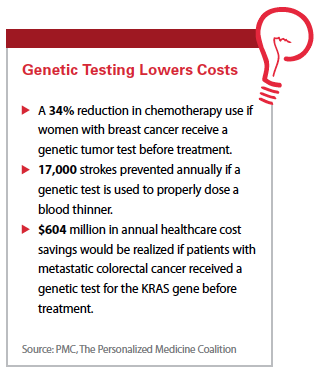The pharmaceutical industry — after facing dramatic changes over the past 10 years or so — has more transformative changes ahead. With an increasingly restrictive physician landscape, an ever-changing payer market, and technological advances that are speeding processes and improving data collection that result in real-world data, the industry is set to reinvent itself into a real-world, value-based — as opposed to a volume-based — ecosystem. Innovative companies are bringing that transformation to bear by developing solutions that help the industry create a new footing in the changing world of healthcare.
The advance of molecular diagnostics, consumer empowerment, and evolving payer and regulatory paradigms are propelling the industry into a completely new approach to commercialization and development. As exciting as the future is, there is still a great deal that needs to change to achieve sustainable success.
“Separating success from failure is an organization’s ability to create game-changing insights and then being flexible enough to adopt a new business model," says Robert Merkel, healthcare and life sciences leader, IBM Watson Group.
According to Cynthia LaConte, CEO of Dohmen Life Science Services, consumer brands understand the virtuous cycle of creating and improving products that add value to their customers’ lives. Burdened by historic product development models, the life-sciences industry hasn’t had the same experience with developing consumer relationships.
“The industry has traditionally focused on intermediaries as its customer, stopping short of engaging the patient in an ongoing dialogue," she says. “Given the advances we’ve seen in molecular diagnostics, the potential of an increasingly bespoke healthcare model is starting to emerge. This shift from a one-size-fits-all approach to one that’s rooted in establishing a more tailored care protocol demands a more direct relationship with the patient. Using rare disease as a proxy for small, targeted disease states, we can see a new, more collaborative relationship emerge between the life-sciences company and the patient. This relationship begins with development and continues through diagnosis and day-to-day care."
The life-sciences industry has not always been able to follow innovative paradigms of other industries due to its healthcare mission, but in a marketplace increasingly driven by clinical efficacy and value-based outcomes, understanding the customer becomes as important for pharma companies as it is for Pepsi.
“The opportunity for our industry to advance transformative change lies in our ability to quantify value for payers," Ms. LaConte says. “Unless a company deeply understands its customers and how its products are differentiated, it is going to miss the opportunities the next decade of transformative change offers."
As the industry prepares for the sea change, Ms. LaConte encourages leaders to be open-minded and learn from other successful paradigm shifts in and outside of the industry. The transformational change will be ongoing as new innovations create better methods of doing business — from research and development to commercialization.
“The model that will be in place 10 years from now will not resemble the model of today," Ms. LaConte says.
Driving Transformational Change
IBM has created solutions that address the trends that are shaping transformational thinking by using its cognitive computing system.
“We fundamentally believe the new era of cognitive computing has begun," Mr. Merkel says. “We believe there is going to be decades of transformation ahead for cognitive systems, similar to the decades of transformation for programmable systems."
IBM has focused on three mega trends in particular: the evolution of care delivery models, the proliferation of science, and the movement to consumerism.
For example, IBM is leveraging advances in its cognitive ability and working with a half dozen major leading hospitals to solve major health issues, such as identifying patterns in genome sequencing, more quickly identifying tumors, recommending specific treatments, discovering new solutions for oncology, diabetes, and more.
“With Watson we are trying to replicate the way the brain sees the world around it, reasons, relates to other individuals, and learns from those experiences," Mr. Merkel says. “We are creating a world of collective intelligence where machine and man can work together to do things not yet thought possible."
Mr. Merkel says there are two types of transformations that can be enabled through cognitive computing: mining information out of vast banks of information quickly and replicating and scaling the best expertise in any given function.
Take IBM’s Watson Discovery Advisor, for example. This first-of-its-kind system can visually reveal patterns and pinpoint connections in data to accelerate the discovery process, which allows scientists and researchers to discover and act upon new patterns and connections in disparate data, helping solve questions without known answers. Several healthcare and life-sciences groups are enlisting Watson to speed up discovery, including Baylor College of Medicine, Johnson & Johnson, and Sanofi.
Sponsors can input vast amounts of information and intellectual property into Watson. For example, there is one version that includes 12 million chemical structures, 20,000 genes, 50 medical textbooks, all content of Medline, and 100 other journal sources, plus the entire FDA drug database and patient database, Mr. Merkel says.
Researchers can ask broad-based questions, such as which proteins act in a specific way under a set of certain circumstances, and receive an answer in much less time than they would through traditional means.
“Instead of reading through all the materials and journals, researchers can look at a knowledge graph created by Watson," he says. “This is going to dramatically impact the industry."
The amount of health information generated is only going to increase in volume beyond anyone’s imagination. There are more than 700,000 new articles published each year and the amount of medical literature generated doubles every three to five years.
“Factor in observational data from FitBits and EMRs, there is just an absolute explosion of information," Mr. Merkel says.
IBM Watson and Baylor College of Medicine are testing a new tool — KnIT — as a proof-of-principle that could one day help researchers mine all public medical literature and formulate hypotheses that promise the greatest reward when pursuing new scientific studies. Baylor was hoping to streamline the discovery process for p53 protein targets, which in humans are encoded by the TP53 gene crucial in multicellular organisms, where it regulates the cell cycle and, thus, functions as a tumor suppressor, preventing cancer.
“There are 70,000 articles on p53 alone, and even if a researcher’s focus was just on this one protein he or she could only read 100 to 200 journal articles a year," Mr. Merkel says.
Enter KnIT, a system that aims to mine the information contained in the scientific literature, represent it explicitly in a network that can be queried, and then further attempt to use the data to generate new reasonable and testable hypotheses that can be used to help direct laboratory studies.
In the study, the team used KnIT to mine the medical literature available up to 2003 when only half of the 33 phosphorylating protein kinases had been discovered. Using KnIT, 74 kinases were extracted as potential modifiers. Of these, prior to 2003, 10 were known to phosphorylate p53, nine were discovered at a later date. Of the 10 already known, KnIT accounted for them in reasoning as well as ranking the likelihood that the other 64 kinases targeted p53. KnIT accurately predicted seven out of the nine previously discovered.
The long-term goal of this system is to systematically extract knowledge directly from the totality of the public medical literature. According to the report, this first study is promising, because it suggests a proof of principle for a small piece of this type of knowledge discovery. With more research, the partnership between IBM and Baylor hope to get closer to clinical and therapeutic applications.
“Watson is creating a new partnership between people and computers that enhances, scales, and accelerates human expertise," Mr. Merkel says.
Real-Word Evidence Key to Strategic Development
Experts say real-word evidence, or rather the availability of tools that can document and understand real-world experiences of patients, will allow companies to incorporate insights into strategic research and planning.
“Pharma is still seduced by efficacy established in a near perfect clinical setting," says Optum Life Sciences President Brian Kelly. “Real-world evidence, used properly, is like ultra definitive radar into how the health system really operates, where value is lost and where it can be gained."
Organizations are building infrastructures and platforms and investing in data assets.
“These investments will bring the industry closer to the patient, and from there, untapped sources of value will be realized," Mr. Kelly says. “It takes foresight and courage to invest in these programs, but it sure beats money spent on traditional detailing."
Precision Medicine Leads Value Transformation
Ms. LaConte views precision medicine as the “next frontier" spurring the transition from volume to value.
“We see the precision medicine paradigm as the one that will unlock true value for our industry," she says. “Increasing disease awareness using a patient’s specific genotype will provide the information necessary to provide better diagnosis and a more effective standard of care that combines both the product and the services that should wrap around it."
A shift in healthcare spending will follow this trend.
“We spend $2.8 trillion on healthcare in this country, yet much of that money is wasted on ineffective treatments," Ms. LaConte says. “Using genomics to understand individual risk profiles for better prevention and to develop breakthrough therapies if a disease does present has the power to dramatically increase the effectiveness of that spend. Much of disease-related costs in this country are preventable, and if we shift those dollars away from the broad-brush models and pour more into targeted prevention, treatment and cure, we can alleviate the massive economic burden that diseases like diabetes, heart disease, and cancer place upon our society."
“While the industry has the opportunity and obligation to focus on developing and marketing products tailored toward more specific patient populations, pharma also has the obligation to evolve its business models so that personalized medicine can reach those patients who would benefit the most," says Brett Kleger, chief commercial officer, DrugDev.
Mr. Kleger does not see this as requiring an overhaul of business models, but rather a simple evolution to smartly use data and technology to bring medicines to the most relevant patients only, and identify specific unmet needs for others.
“We now have much better ways to find the relevant doctors and patients, so instead of developing and marketing products to the masses, we can use the same tactics but tailor them to a better defined market," he says.
Sheila Rocchio, VP of marketing and corporate strategy, PHT Corp., believes that the current business model is essentially a commercialized form of the scientific method, which may not have to change as hypotheses and evidence still need to exist to prove safety and efficacy of a medicine.
“But the ways in which we ask the questions and gather the evidence will change dramatically," she says.
Patient Centricity: A Crucial Part of the Value Paradigm
One of the challenges facing the industry as it reinvents itself will be shifting from a model focused on product to one around patient-centricity.
“Over the years, pharma companies moved further away from patients," says Laura Strong, Ph.D., president and chief operating officer of Quintessence Biosciences. “Patient-centric has become a much-used phrase in the industry but the implementation of such a model is much more challenging than reorienting the sales and marketing portion of today’s pharma industry. A significant part of the challenge is that although the end-users of products are the patients, there are many stakeholders in between, including payers and clinicians."
Some of the other intermediaries include pharmacy-benefit management companies (PBMs) and disease management companies.
Among the most famous pharma-PBM relationships is Merck-Medco. Merck bought Medco Health in 1993 and then spun it out a decade later. In the same era, other pharma companies experimented with disease management either internally (Lilly) or externally (Zeneca and Salick Health Care). The history of these niches should be considered as companies evaluate what functions should be built, acquired, or partnered.
Recently, insurance companies have begun providing varying levels of encouragement to adhere to guidelines of care, also known as quality programs. Cigna has indicated it will use the National Comprehensive Cancer Network (NCCN) evidence-based guidelines and compendium for coverage policy. WellPoint has developed its own Cancer Treatment Pathways, which are determined using national guidelines as well as cost information. The level of reimbursement is correlated with adherence to treatments in the pathway. UnitedHealthcare recently published the results of a similar pilot program of “bundled" payments in a handful of oncology clinics.
“Pharmaceutical companies must move beyond just branding a product and instead develop tools and systems to improve adherence for patients as well as clinical teams," Dr. Strong says. “While technology provides a plethora of opportunities for encouraging adherence, the true innovation will come from understanding why poor adherence occurs."
For patients, these issues may be as clear as cost or as challenging as individual modifications of dosing and scheduling to maximize benefits and reduce side effects, which cause patients to stop taking their medications.
The biggest challenges to a patient-focused model will be to keep it simple and work together with all relevant stakeholders, including regulators, to get back to the basics of focusing on the patient, Mr. Kleger adds. While healthcare does present some unique considerations, particularly around privacy, many industries have solved the issues of how to tailor solutions to specific audiences.
“The pharma industry just needs to follow suit and use best practices from other industries," he says. “Likewise, when privacy or security concerns are raised we should work together with all stakeholders, including regulators and legal teams, to find solutions and not obstacles. At the end of the day the opportunity to serve patients is far too important."
The shift from product- to patient-focus has to include identifying when and where to use and stop using the product; enabling access for the patient; and demonstrating clearly how efficacy of the product is greater than the risks, Dr. Strong says.
While these activities involve significant technical acumen, the business risk is that these features may soon become a requirement, rather than a wish list, for purchasing the product.
“Perhaps the biggest challenge for the pharmaceutical industry will be accurately evaluating and reducing the business risks of the multi-player landscape of the patient-centric healthcare model," she says.
The Future
With aging patients from the blockbuster generation juggling up to 20 prescriptions, Ms. Rocchio believes a more targeted, patient-centric approach to healthcare is necessary.
“Imagine a future where patients and their doctors know with much greater certainty if the medicines they take work specifically for them vs. the population at large based on their specific electronic medical records, DNA, physiological measures, and patient reported outcomes," she says. “I can imagine having a Siri-like virtual medical assistant who can help guide choices and complement the advice, review, and support of a physician."
Getting to this new world is the challenge and drug developers are preparing for this change by investing in more technologies, looking at ways to not just treat disease but manage health, and involving patient advocates and patient groups early on in the drug development process. The rate of innovation that will allow patients and consumers to conduct medical-based diagnostic testing and measurement at home is accelerating tremendously.
“With mobile and sensor technology exploding, harnessing all that data and turning it into faster, more effective, and safer medicines that are both cost-effective and profitable are keys to reinvention," Ms. Rocchio says. (PV)
~~~~~~~~~~~~~~~~~~~~~~~~~~~~~~~~
Case Study: Using RWE to Improve Outcomes
Real-world data identifies treatment issues quicker and cheaper.
A global pharmaceutical company specializing in neurology wanted to understand why patients were seemingly undertreated with tissue plasminogen activator (tPA), a protein involved in the breakdown of blood clots during acute ischemic stroke, even though improvements in outcomes had been documented.
The sponsor company used real-world data sets — a combination of claims, clinical, and provider data — to examine the root cause of the problem. The study discovered that the use of tPA was limited in large part due to a small treatment window. The label states that bleed risk can occur if the medicine is not administered within a three to four and a half hour window post-event.
Once the problem was identified, ananalysis of patient and claims data was conducted to examine the relationship between tPA treatment frequency and hospital-level characteristics, for example length of hospital stay, critical care — administered, rehospitalization, and rehabilitation.
In just weeks, real-world evidence (RWE) confirmed a clear association between the experience level of the facilities involved and tPA use and outcomes. Based on the evidence, the manufacturer committed capital and resources to develop a protocol to adjust treatment frequency. This new treatment protocol was identified and adjusted in a matter of weeks for much less than the millions of dollars of a large, time-consuming outcomes.
~~~~~~~~~~~~~~~~~~~~~~~~~~~~~~~~~

The model of the future is about developing a more direct connection between life-science innovators and their customers — patients.
Cynthia LaConte / Dohmen Life Science Services

Pharmaceutical companies must move beyond just branding a product to
developing tools to improve adherence for patients.
Dr. Laura Strong / Quintessence Biosciences

A key to reinvention is finding a way to harness data and turn it into faster, more effective, and safer clinical development and medicines.
Sheila Rocchio / PHT

The industry has the obligation to evolve its business models so that personalized medicine can reach those patients who would benefit.
Brett Kleger / DrugDev

The value derived from new capabilities is a complete game changer and it’s not in the future — it’s here.
Robert Merkel / IBM Watson Group
 Real-world evidence is the ultra-definitive radar into how the health system really operates, where value is lost, and where it can be gained.
Real-world evidence is the ultra-definitive radar into how the health system really operates, where value is lost, and where it can be gained.
Brian Kelly / Optum Life Sciences

















